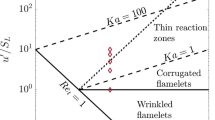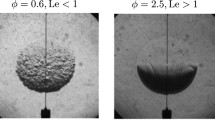Abstract
This paper reports on the numerical study of the linear stability of laminar premixed flames under zero gravity. The study specifically addresses the dependence of stability on finite rate chemistry with low activation energy and variable thermodynamic and transport properties. The calculations show that activation energy and details of chemistry play a minor role in altering the linear neutral stability results from asymptotic analysis. Variable specific heat makes a marginal change to the stability. Variable transport properties on the other hand tend to substantially enhance the stability from critical wave number of about 0.5 to 0.20. Also, it appears that the effects of variable properties tend to nullify the effects of non-unity Lewis number. When the Lewis number of a single species is different from unity, as will happen in a hydrogen-air premixed flame, the stability results remain close to that of unity Lewis number.
Similar content being viewed by others
Abbreviations
- A f :
-
Frequency factor for the forward reaction
- A b :
-
Frequency factor for the backward reaction
- Y i :
-
Mass fraction of speciesi
- \(\dot \omega _i^m \) :
-
Volumetric reaction rate of speciesi
- c p :
-
Specific heat at constant pressure
- D i :
-
Trace diffusion coefficient ofspeciesi
- E :
-
Activation energy
- h i :
-
Enthalpy of speciesi
- h s :
-
Sensible enthalpy of the mixture
- h ct :
-
Heat of combustion of the reaction
- h o i :
-
Heat of formation of speciesi
- J i,j :
-
Jacobian of the reactioni with respect to speciesj
- k :
-
Wave number
- Le i :
-
Lewis number of speciesi
- M i :
-
Molecular weight of speciesi
- ns :
-
Number of Species=4, here
- p :
-
Pressure
- Pr:
-
Prandtl number
- R:
-
Universal gas constant
- Re :
-
Reynolds number
- s :
-
Stoichiometric ratio
- T :
-
Temperature
- T r :
-
Reference temperature = initial temperature
- T ad :
-
Adiabatic flame temperature
- t :
-
Time
- u :
-
Streamwise velocity
- v :
-
Transverse velocity
- x :
-
Streamwise coordinate
- y :
-
Transverse coordinate
- z :
-
product of density andu velocity
- κ :
-
Conductivity
- τ :
-
Non-dimensional temperature
- δ f :
-
Flame thickness
- φ :
-
Disturbance function
- θ :
-
Activation parameter
- γ :
-
Ratio of specific heats
- ρ :
-
Density
- μ :
-
Laminar viscosity
- ω :
-
Coefficient of time in the disturbance
- f :
-
Perturbed quantity
- r :
-
Value at reference condition
- s :
-
Steady state
- i :
-
Species identity, 1 for fuel, 2 for oxidizer, 3 for product and 4 for inert
References
Bhashyam, A.T., Deshpande, S.M., Mukunda, H.S. and Goyal, G.: A novel operator splitting technique for one dimensional flame.Comb. Sci and Tech. 46 (1986) 223–248.
Clavin, P.: Dynamic behavior of premixed flame fronts in laminar and turbulent flows.Prog. Energy Comb. Sci. 11 (1985) 1–59.
Clavin, P. and Garcia, P.: The influence of the temperature dependence of diffusivities on the dynamics of flame fronts.J. Mec. Therm. Appl. 2 (1983) 245.
Darrieus, G.,Congress de Mecanique Appliquee Paris (1945).
Fenn, J.B. and Calcote, H.F.: Activation energies in high temperature combustion,Fourth Symposium (international) on Combustion (1957) pp. 231–239.
Frankel, M.L. and Sivashinsky, G.I.: The effect of viscosity on the hydrodynamic stability of a plane flame front.Comb. Sci. and Tech. 39 (1982) 207–224.
Goyal, G., Paul, P.J., Mukunda, H.S. and Deshpande, S.M.: Further computational studies on the efficiency of operator split methods for one dimensional flames.Comb. Sci. and Tech. 43 (1989) 167–179.
Jackson, T.L. and Kapila, A.K.: Effect of thermal expansion on the stability of plane freely propagating flames.Comb. Sci. and Tech. 41 (1984) 191–201.
Jackson, T.L. and Kapila, A.K.: Effect of thermal expansion on the stability of plane freely propagating flames, Part II Incorporation of gravity and heat loss.Comb. Sci. and Tech. 49 (1986) 305–317.
Landau, L.:Acta Physiochem, URSS 19 (1944) 77.
Macaraeg, M.L., Street, C.L. and Hussaini, M.Y.: A spectral collocation solution to the compressible stability eigenvalue problem.NASA TP 2858 (1988).
Matalon, M. and Matkowsky, B.J.: Flames as gas dynamic discontinuities.J. Fluid Mech. 124 (1982) 239–259.
Mukunda, H.S., Deshpande, S.M. and Bhashyam, A.T.: New formulation for one dimensional premixed flames.AIAA Jl 24 (1986) 1127–1128.
Pelce, P., Clavin, P.: Influence of hydrodynamics and diffusion upon the stability limits of laminar premixed flames.J. Fluid Mech. 124 (1982) 219–237.
Spalding, D.B.: Predicting the laminar flame speeds in gases with temperature-explicit reaction rates, Parts I and II.Comb. and Flame 1 (1957) 287–307.
Author information
Authors and Affiliations
Rights and permissions
About this article
Cite this article
Mukunda, H.S., Drummond, J.P. Two dimensional linear stability of premixed laminar flames under zero gravity. Appl. Sci. Res. 51, 687–711 (1993). https://doi.org/10.1007/BF00849273
Received:
Accepted:
Issue Date:
DOI: https://doi.org/10.1007/BF00849273




